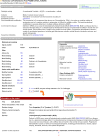From protein sequences to 3D-structures and beyond: the example of the UniProt knowledgebase
- PMID: 20043185
- PMCID: PMC2835715
- DOI: 10.1007/s00018-009-0229-6
From protein sequences to 3D-structures and beyond: the example of the UniProt knowledgebase
Abstract
With the dramatic increase in the volume of experimental results in every domain of life sciences, assembling pertinent data and combining information from different fields has become a challenge. Information is dispersed over numerous specialized databases and is presented in many different formats. Rapid access to experiment-based information about well-characterized proteins helps predict the function of uncharacterized proteins identified by large-scale sequencing. In this context, universal knowledgebases play essential roles in providing access to data from complementary types of experiments and serving as hubs with cross-references to many specialized databases. This review outlines how the value of experimental data is optimized by combining high-quality protein sequences with complementary experimental results, including information derived from protein 3D-structures, using as an example the UniProt knowledgebase (UniProtKB) and the tools and links provided on its website ( http://www.uniprot.org/ ). It also evokes precautions that are necessary for successful predictions and extrapolations.
Figures


References
-
- Berman H, Henrick K, Nakamura H. Announcing the worldwide Protein Data Bank. Nat Struct Biol. 2003;10:980. - PubMed
-
- Dutta S, Burkhardt K, Young J, Swaminathan GJ, Matsuura T, Henrick K, Nakamura H, Berman HM. Data deposition and annotation at the worldwide protein data bank. Mol Biotechnol. 2009;42:1–13. - PubMed
-
- Boutselakis H, Dimitropoulos D, Fillon J, Golovin A, Henrick K, Hussain A, Ionides J, John M, Keller PA, Krissinel E, McNeil P, Naim A, Newman R, Oldfield T, Pineda J, Rachedi A, Copeland J, Sitnov A, Sobhany S, Suarez-Uruena A, Swaminathan J, Tagari M, Tate J, Tromm S, Velankar S, Vranken W. E-MSD: the European Bioinformatics Institute Macromolecular Structure Database. Nucleic Acids Res. 2003;31:458–462. - PMC - PubMed
Publication types
MeSH terms
Substances
Grants and funding
LinkOut - more resources
Full Text Sources
Other Literature Sources

